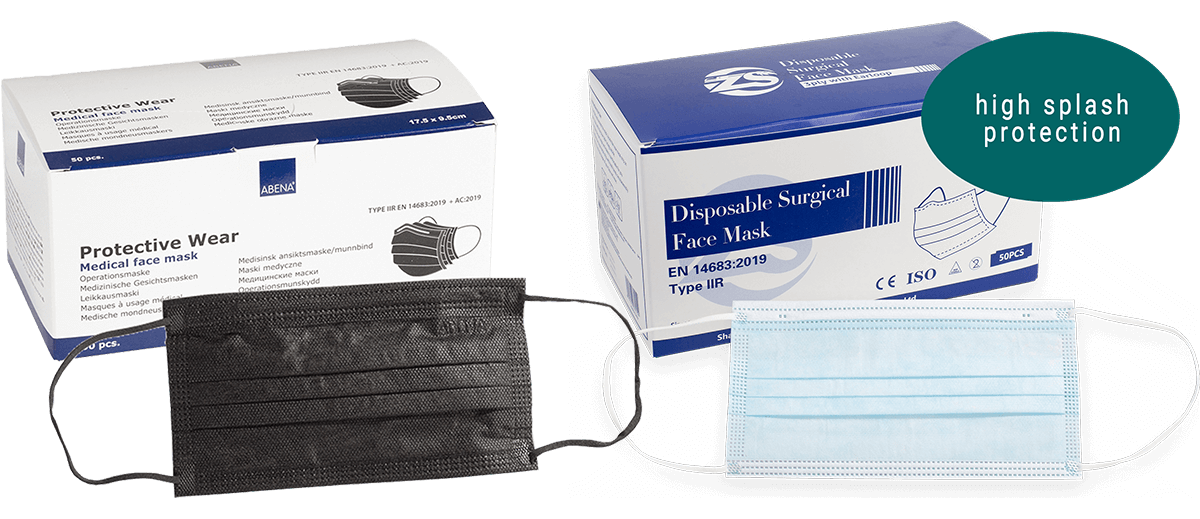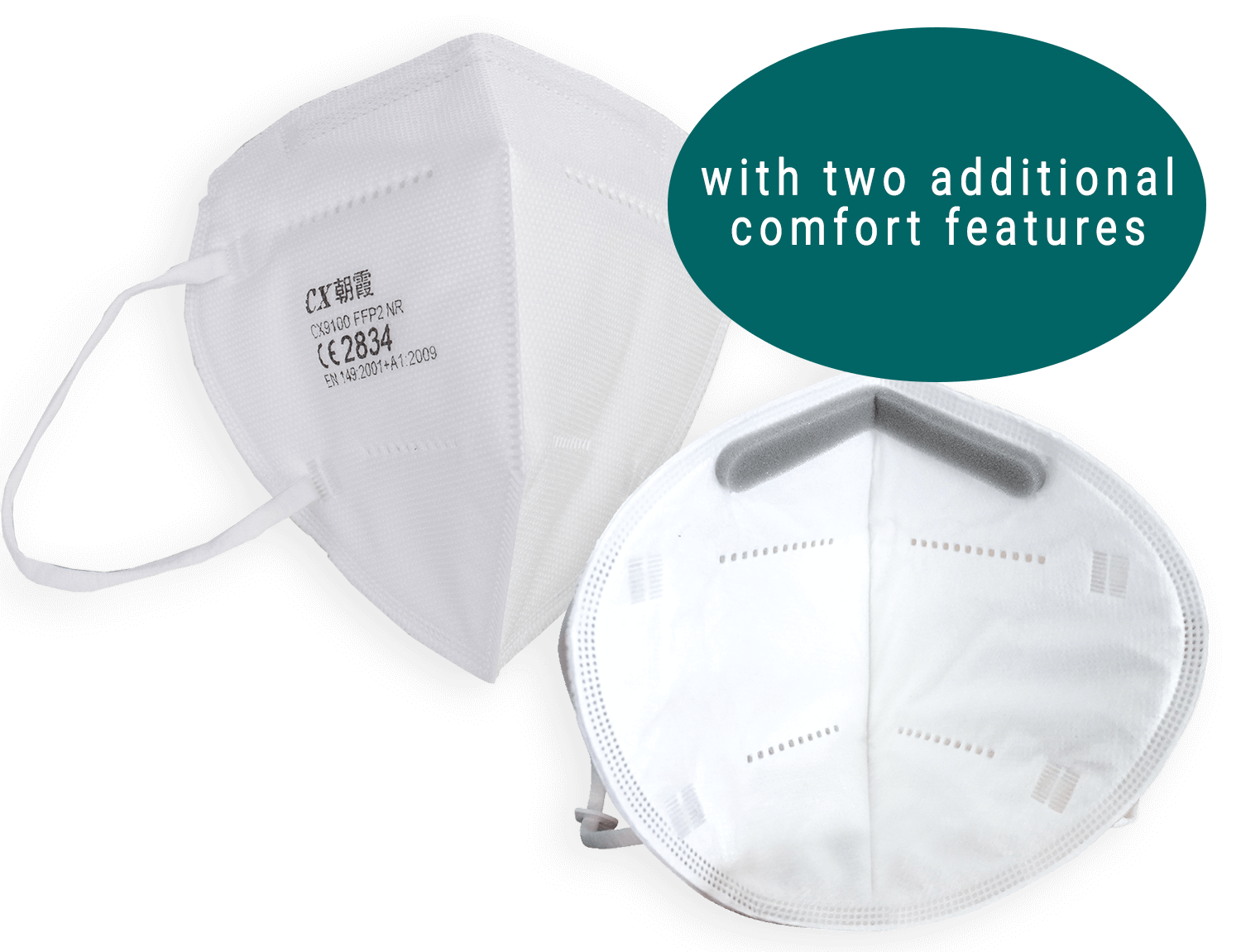Protective Masks (Infection)
Medical face masks (hygiene masks) and respirators (FFP2) protect against the spread of infection. Here we present the two most important types of mask used to minimise the spread of infection in times of pandemic. We would also like to draw your attention to our tips for using the protective masks correctly.
Two aspects determine the level of protection provided by a mask: the fit and the quality of the materials. Wetrok makes no compromises on either. We only sell tested and certified protective masks – stating the respective test standard on each product. Our Wetrok experts also subject every new Wetrok mask to a rigorous internal testing procedure (shape test, water test, filter layer test and fire test). You will find the following information printed on each mask: mask type, test standard(s), CE mark. You will also receive a certificate with further information on durability etc. with your mask. On request, we will of course be happy to provide you with more detailed test reports and answer any questions you may have concerning safety and quality:
info@wetrok.chThe health authorities have recently reported that there are counterfeit masks in circulation. These have no test certificates, insufficient filter efficiency, may contain hazardous materials and may have been produced under questionable hygiene conditions. In short: They are ineffective and unfit for use. It is therefore important to look carefully when buying masks!
Protective Masks: Protection for the Wearer or the Surroundings?
Protective masks serve two basic functions: They protect the wearer and/or their surroundings. Wetrok offers two different types of protective mask for different applications:
Medical face masks reduce the transmission of pathogens through droplets. They provide protection against the spread of infection in times of epidemic or pandemic. The primary function of a medical face mask is to protect others against infection (NOT the wearer). However, type IIR medical face masks also provide the wearer with limited protection against droplets or infection.
Important: These are disposable products that – depending on the manufacturer – may be worn for a maximum of three hours. Any longer and protection is no longer guaranteed!

- High level of protection for the wearer’s surroundings (type IIR)
- High bacterial filtration efficiency ≥ 98%
- Tested and certified in accordance with EN 14683:2019
- Three-layer filter medium (and yet very lightweight)
- Very comfortable to wear (adjustable nose bridge, soft elastic loops)
- Low breathing resistance
- Can be worn for a maximum of 2–3 hours (max. 2 hours in hospitals)
- Available in a box of 50 pcs.
Order black medical face masks from the online shop
FFP2 respirators protect against aerosols, dust and smoke. In times of pandemic, FFP2 respirators provide particularly good protection against virus transmission. In contrast to medical face masks, type FFP2 (and FFP3) respirators protect both the wearer AND their surroundings.
Safety information: Respirators with a valve do NOT protect the surroundings, as any viruses are released back into the air through the exhalation valve and allowed to spread when the wearer exhales.
-> Wetrok FFP2 respirators are therefore NOT equipped with an exhalation valve..
FFP2 masks offer maximum safety and can be worn for a longer period of time than medical masks. FFP2 masks are – when used correctly – also recommended for cleaning staff who are in contact with COVID-19-infected persons or working in contaminated rooms.

- High level of protection for the wearer and their surroundings (protection class FFP2)
- Tested and certified in accordance with EN 149:2001 A1:2009
- CE certified (CE2834)
- Optimum seal and fit thanks to adjustable nose bridge
- Extremely comfortable to wear
- Multilayer filter medium with high-quality non-woven material
- Very lightweight
- Can be worn for a maximum of five 75-minute shifts in accordance with DGUV
- High degree of protection against droplets
- Available in different order quantities: box of 20 pieces (each individually packaged in a plastic bag) or as a single item (1 mask in a plastic bag)
This mask offers two unbeatable features for maximum comfort:
Supple nose bridge: The nose bridge is covered with a soft, skin-friendly foam insert, making it more comfortable, better fitting and more resistant to wear – especially for those who wear glasses.
Flexible fastening: You can use the elastic bands to fasten the mask behind your ears, or use the plastic clip provided to fasten it behind your head. If you experience any pinching or discomfort, you can simply switch to the other fastening method.
You will never want to do without these features again!
Order FFP2 respirators from the online shop (box of 20 pcs.)Order FFP2 respirators from the online shop (1 pc.)
- When putting on your mask, only touch the mask after washing or disinfecting your hands.
- Only touch the mask by the elastic bands.
- Make sure the mask fully covers the mouth, nose and chin.
- Make sure the mask fits snugly (practice putting it on in front of a mirror).
- If you wear glasses; first put on the mask, then your glasses.
- Tie back long hair to prevent the mask from slipping.
- While wearing the mask, continue to practice good hand hygiene and keep a safe distance from others.
- Do not touch the mask while wearing it.
- Once you have put on the mask, do not take it off (including pulling it down under your chin).
- If your mask becomes wet, replace it with a clean, dry mask (after approx. two hours).
- After taking off the mask, dispose of it in a sealed container.
- Wash or disinfect your hands after taking off the mask.
One last tip: Never throw masks carelessly on the ground and never leave them lying in public spaces (deadly hazard for wildlife and high impact on the environment).

1. Wash hands thoroughly with soap and water and/or disinfect before putting on the mask.
2. Place the mask over your mouth and nose according to the manufacturer’s instructions and fasten it behind your head or ears.
3. There should be no gaps between your face and the mask.
4. Only when the mouth and nose are completely covered is protection guaranteed.
5. Do not touch the mask while wearing it.

1. Wash hands thoroughly with soap and water and/or disinfect before removing the mask.
2. Do not touch the mask itself.
3. Touch the elastic bands only and carefully remove the mask.
4. Dispose of the mask in a sealed container.
5. Wash hands thoroughly with soap and water and/or disinfect after removing the mask.
